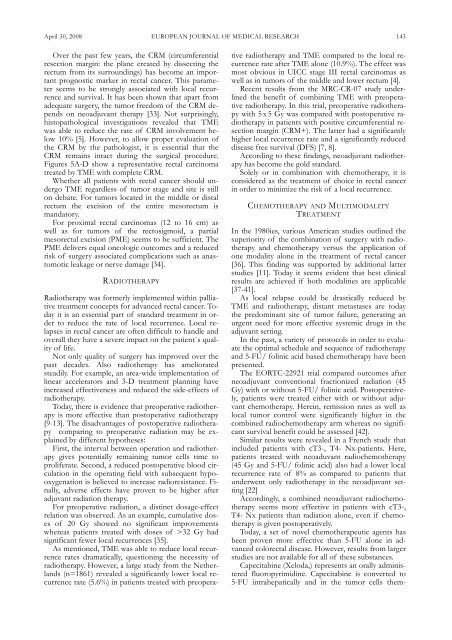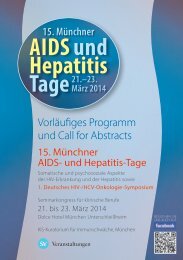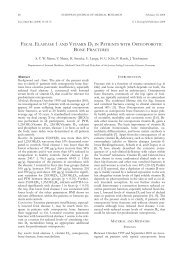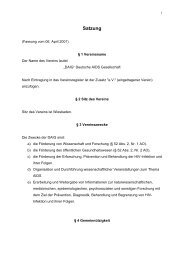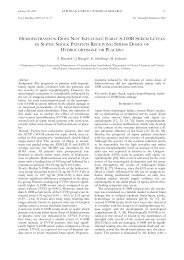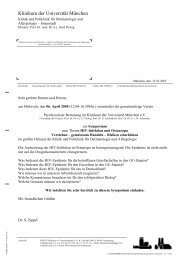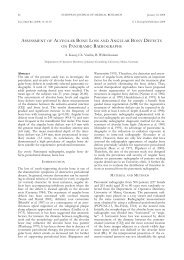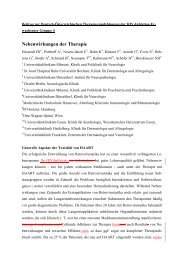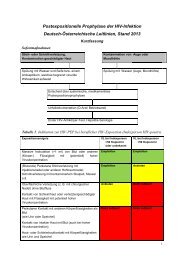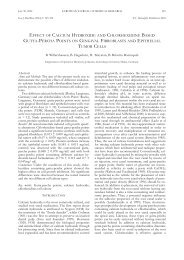MODERN THERAPY OF RECTAL CARCINOMA - ResearchGate
MODERN THERAPY OF RECTAL CARCINOMA - ResearchGate
MODERN THERAPY OF RECTAL CARCINOMA - ResearchGate
You also want an ePaper? Increase the reach of your titles
YUMPU automatically turns print PDFs into web optimized ePapers that Google loves.
April 30, 2008 EUROPEAN JOURNAL <strong>OF</strong> MEDICAL RESEARCH<br />
143<br />
Over the past few years, the CRM (circumferential<br />
resection margin: the plane created by dissecting the<br />
rectum from its surroundings) has become an important<br />
prognostic marker in rectal cancer. This parameter<br />
seems to be strongly associated with local recurrence<br />
and survival. It has been shown that apart from<br />
adequate surgery, the tumor freedom of the CRM depends<br />
on neoadjuvant therapy [33]. Not surprisingly,<br />
histopathological investigations revealed that TME<br />
was able to reduce the rate of CRM involvement below<br />
10% [5]. However, to allow proper evaluation of<br />
the CRM by the pathologist, it is essential that the<br />
CRM remains intact during the surgical procedure.<br />
Figures 5A-D show a representative rectal carcinoma<br />
treated by TME with complete CRM.<br />
Whether all patients with rectal cancer should undergo<br />
TME regardless of tumor stage and site is still<br />
on debate. For tumors located in the middle or distal<br />
rectum the excision of the entire mesorectum is<br />
mandatory.<br />
For proximal rectal carcinomas (12 to 16 cm) as<br />
well as for tumors of the rectosigmoid, a partial<br />
mesorectal excision (PME) seems to be sufficient. The<br />
PME delivers equal oncologic outcomes and a reduced<br />
risk of surgery associated complications such as anastomotic<br />
leakage or nerve damage [34].<br />
RADIO<strong>THERAPY</strong><br />
Radiotherapy was formerly implemented within palliative<br />
treatment concepts for advanced rectal cancer. Today<br />
it is an essential part of standard treatment in order<br />
to reduce the rate of local recurrence. Local relapses<br />
in rectal cancer are often difficult to handle and<br />
overall they have a severe impact on the patient`s quality<br />
of life.<br />
Not only quality of surgery has improved over the<br />
past decades. Also radiotherapy has ameliorated<br />
steadily. For example, an area-wide implementation of<br />
linear accelerators and 3-D treatment planning have<br />
increased effectiveness and reduced the side-effects of<br />
radiotherapy.<br />
Today, there is evidence that preoperative radiotherapy<br />
is more effective than postoperative radiotherapy<br />
[9-13]. The disadvantages of postoperative radiotherapy<br />
comparing to preoperative radiation may be explained<br />
by different hypotheses:<br />
First, the interval between operation and radiotherapy<br />
gives potentially remaining tumor cells time to<br />
proliferate. Second, a reduced postoperative blood circulation<br />
in the operating field with subsequent hypooxygenation<br />
is believed to increase radioresistance. Finally,<br />
adverse effects have proven to be higher after<br />
adjuvant radiation therapy.<br />
For preoperative radiation, a distinct dosage-effect<br />
relation was observed. As an example, cumulative doses<br />
of 20 Gy showed no significant improvements<br />
whereas patients treated with doses of >32 Gy had<br />
significant fewer local recurrences [35].<br />
As mentioned, TME was able to reduce local recurrence<br />
rates dramatically, questioning the necessity of<br />
radiotherapy. However, a large study from the Netherlands<br />
(n=1861) revealed a significantly lower local recurrence<br />
rate (5.6%) in patients treated with preopera-<br />
tive radiotherapy and TME compared to the local recurrence<br />
rate after TME alone (10.9%). The effect was<br />
most obvious in UICC stage III rectal carcinomas as<br />
well as in tumors of the middle and lower rectum [4].<br />
Recent results from the MRC-CR-07 study underlined<br />
the benefit of combining TME with preoperative<br />
radiotherapy. In this trial, preoperative radiotherapy<br />
with 5x5 Gy was compared with postoperative radiotherapy<br />
in patients with positive circumferential resection<br />
margin (CRM+). The latter had a significantly<br />
higher local recurrence rate and a significantly reduced<br />
disease free survival (DFS) [7, 8].<br />
According to these findings, neoadjuvant radiotherapy<br />
has become the gold standard.<br />
Solely or in combination with chemotherapy, it is<br />
considered as the treatment of choice in rectal cancer<br />
in order to minimize the risk of a local recurrence.<br />
CHEMO<strong>THERAPY</strong> AND MULTIMODALITY<br />
TREATMENT<br />
In the 1980ies, various American studies outlined the<br />
superiority of the combination of surgery with radiotherapy<br />
and chemotherapy versus the application of<br />
one modality alone in the treatment of rectal cancer<br />
[36]. This finding was supported by additional latter<br />
studies [11]. Today it seems evident that best clinical<br />
results are achieved if both modalities are applicable<br />
[37-41].<br />
As local relapse could be drastically reduced by<br />
TME and radiotherapy, distant metastases are today<br />
the predominant site of tumor failure, generating an<br />
urgent need for more effective systemic drugs in the<br />
adjuvant setting.<br />
In the past, a variety of protocols in order to evaluate<br />
the optimal schedule and sequence of radiotherapy<br />
and 5-FU/ folinic acid based chemotherapy have been<br />
presented.<br />
The EORTC-22921 trial compared outcomes after<br />
neoadjuvant conventional fractionized radiation (45<br />
Gy) with or without 5-FU/ folinic acid. Postoperatively,<br />
patients were treated either with or without adjuvant<br />
chemotherapy. Herein, remission rates as well as<br />
local tumor control were significantly higher in the<br />
combined radiochemotherapy arm whereas no significant<br />
survival benefit could be assessed [42].<br />
Similar results were revealed in a French study that<br />
included patients with cT3-, T4- Nx-patients. Here,<br />
patients treated with neoaduvant radiochemotherapy<br />
(45 Gy and 5-FU/ folinic acid) also had a lower local<br />
recurrence rate of 8% as compared to patients that<br />
underwent only radiotherapy in the neoadjuvant setting<br />
[22]<br />
Accordingly, a combined neoadjuvant radio chemo -<br />
therapy seems more effective in patients with cT3-,<br />
T4- Nx patients than radiation alone, even if chemo -<br />
therapy is given postoperatively.<br />
Today, a set of novel chemotherapeutic agents has<br />
been proven more effective than 5-FU alone in advanced<br />
colorectal disease. However, results from larger<br />
studies are not available for all of these substances.<br />
Capecitabine (Xeloda‚) represents an orally administered<br />
fluoropyrimidine. Capecitabine is converted to<br />
5-FU intrahepatically and in the tumor cells them-


